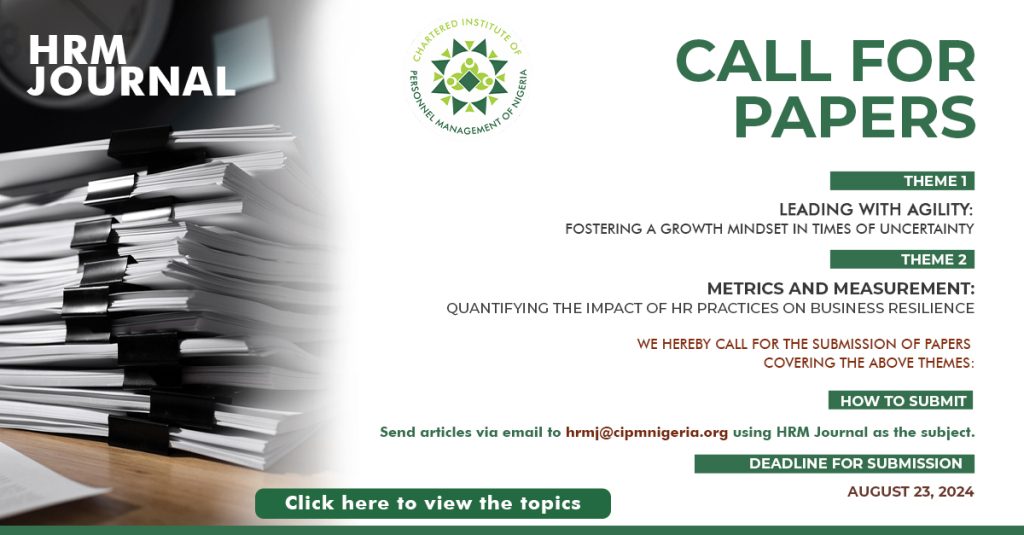CIPM welcomes submission of relevant and timely articles to support the HR professionals to gain more knowledge in the practice of Human Resource Management (HRM). Writers are expected to choose one of the underlisted topics. They may also expand their views beyond the guides given under each topic where relevant and applicable.
Papers should be submitted based on the following themes:
THEME 1: Leading with Agility: Fostering a Growth Mindset in Times of Uncertainty
This edition of the Human Resource Management Journal seeks to provide insights into the topical issues bordering on Leading with Agility. Submission of articles should be based on any of the following topics:
Topic 1: Introduction to Agility and Growth Mindset
1.1 Definition of Agility in Leadership
– What is agility in the context of leadership?
– Importance of agile leadership in today’s business environment.
1.2 Understanding the Growth Mindset
– Definition of a growth mindset vs. a fixed mindset.
– Benefits of fostering a growth mindset within teams and organizations.
1.3 Relevance of Agility in the Times of Uncertainty
– Why agility and growth mindset are critical during uncertain times.
– Examples of agile leaders who thrived during crises.
Topic 2. Core Principles of Agile Leadership
2.1 Embracing Change and Uncertainty
– Strategies for staying flexible and adaptable.
– Encouraging a culture that sees change as an opportunity.
2.2 Promoting Continuous Learning and Development
– Creating an environment that values learning and growth.
– Implementing continuous improvement practices.
2.3 Enhancing Decision-Making Speed and Quality
– Techniques for making quick, informed decisions.
– Balancing speed with strategic thinking.
Topic 3. Developing a Growth Mindset in Teams
3.1 Encouraging Open Communication and Feedback
– Fostering a culture of open dialogue and constructive feedback.
– Tools and practices for effective communication.
3.2 Setting Challenging Yet Achievable Goals
– How to set SMART goals that motivate and inspire.
– Balancing stretch goals with achievable targets.
3.3 Recognizing and Rewarding Effort and Resilience
– Ways to celebrate efforts, not just outcomes.
– Creating recognition programs that highlight growth and resilience.
Topic 4. Practical Strategies for Leading with Agility
4.1 Implementing Agile Frameworks and Methodologies
– Overview of popular agile methodologies (e.g., Scrum, Kanban).
– Adapting agile practices to leadership and management.
4.2 Building and Leading Cross-Functional Teams
– Benefits of cross-functional collaboration.
– Strategies for effective team building and leadership.
4.3 Leveraging Technology for Agility
– Tools and technologies that support agile working.
– Using data and analytics to drive agile decision-making.
Topic 5. Overcoming Challenges in Fostering a Growth Mindset
5.1 Addressing Resistance to Change
– Identifying common sources of resistance.
– Strategies for managing and overcoming resistance.
5.2 Navigating Setbacks and Failures
– Building resilience and learning from failures.
– Encouraging a ‘fail forward’ mentality.
5.3 Sustaining Momentum and Motivation
– Techniques for maintaining energy and focus over time.
– Keeping teams motivated through ongoing challenges.
Topic 6. Growth Mindset
– Impact of growth mindset on performance and innovation.
Topic 7. Action Planning and Implementation
7.1 Developing a Personal Action Plan
– Steps to implement agile leadership practices in your own role.
– Setting personal goals for growth and agility.
7.2 Creating a Roadmap for Your Team
– Strategies for rolling out growth mindset initiatives within your team.
– Tools for tracking progress and measuring success.
7.3 Continuous Reflection and Improvement
– Importance of regular reflection and feedback.
– Techniques for ongoing improvement and adaptation.
Send articles to hrmj@cipmnigeria.org
Deadline for submission is August 23, 2024
THEME 2: Metrics and Measurement: Quantifying the Impact of HR Practices on Business Resilience
This edition seeks to measure and provide insights into the impact HR practices have on business resilience. Submission of articles should be based on the following topics:
Topic 1. Introduction to HR Metrics and Business Resilience
1.1 Definition of HR Metrics
– What are HR metrics?
– Importance of metrics in HR management.
1.2 Understanding Business Resilience
– Definition of business resilience.
– The role of HR in enhancing business resilience.
1.3 The Connection Between HR Practices and Business Resilience
– How effective HR practices contribute to a resilient business.
– Overview of the key areas where HR impacts business resilience.
Topic 2. Identifying Key HR Metrics
2.1 Workforce Productivity and Performance Metrics
– Measuring employee productivity.
– Performance management metrics.
2.2 Talent Acquisition and Retention Metrics
– Recruitment effectiveness.
– Employee turnover and retention rates.
2.3 Employee Engagement and Satisfaction Metrics
– Employee engagement scores.
– Job satisfaction surveys and indices.
2.4 Learning and Development Metrics
– Training participation rates.
– Skill acquisition and competency development.
2.5 Diversity, Equity, and Inclusion Metrics
– Workforce diversity statistics.
– Inclusion and equity indicators.
Topic 3. Linking HR Metrics to Business Outcomes
3.1 Impact on Financial Performance
– Correlation between HR metrics and financial results.
– Examples of how HR practices drive profitability.
3.2 Enhancing Operational Efficiency
– Role of HR in streamlining operations.
– Metrics that show HR’s impact on operational efficiency.
3.3 Strengthening Organizational Culture
– Influence of HR practices on organizational culture.
– Cultural indicators and their business implications.
3.4 Driving Innovation and Agility
– HR’s role in fostering a culture of innovation.
– Metrics related to innovation and agility.
Topic 4. Data Collection and Analysis Techniques
4.1 Gathering Reliable HR Data
– Methods for collecting accurate HR data.
– Sources of HR data (e.g., HRIS, surveys, performance reviews).
4.2 Analyzing HR Data
– Techniques for analyzing HR data.
– Tools and software for HR analytics.
4.3 Visualizing HR Metrics
– Best practices for visualizing HR data.
– Creating HR dashboards and reports.
Topic 5. Quantifying the Impact of HR Practices
5.1 Successful Implementation of HR Metrics
– Examples of organizations that effectively use HR metrics.
– Lessons learned and best practices.
5.2 Measuring Resilience Through HR Practices
– Examples of how HR practices have enhanced business resilience.
– Quantifiable outcomes and business benefits.
Topic 6. Challenges and Solutions in Measuring HR Impact
6.1 Common Challenges in HR Metrics
– Data quality and reliability issues.
– Resistance to measurement and analytics.
6.2 Overcoming Measurement Challenges
– Strategies for improving data quality.
– Gaining buy-in for HR metrics and analytics.
6.3 Ensuring Continuous Improvement
– Using metrics for ongoing HR improvement.
– Adapting metrics to changing business needs.
Topic 7. Action Planning and Implementation
7.1 Developing an HR Metrics Framework
– Steps to create a comprehensive HR metrics framework.
– Aligning HR metrics with business goals.
7.2 Implementing HR Metrics in Your Organization
– Practical steps for rolling out HR metrics.
– Ensuring stakeholder engagement and support.
7.3 Monitoring and Reviewing HR Metrics
– Establishing a process for regular monitoring.
– Reviewing and adjusting metrics as needed.
Send article to hrmj@cipmnigeria.org using HRM Journal as the Email Subject.
Articles for journal should not exceed 2000 words with font size 12 Times New Romans.
Deadline for Submission is August 23rd, 2024.
N:B- “Only qualitative articles that aligns with the theme shall be published and the publication shall be on first come first served basis”.




